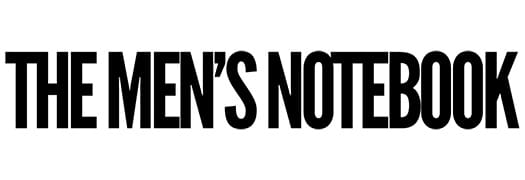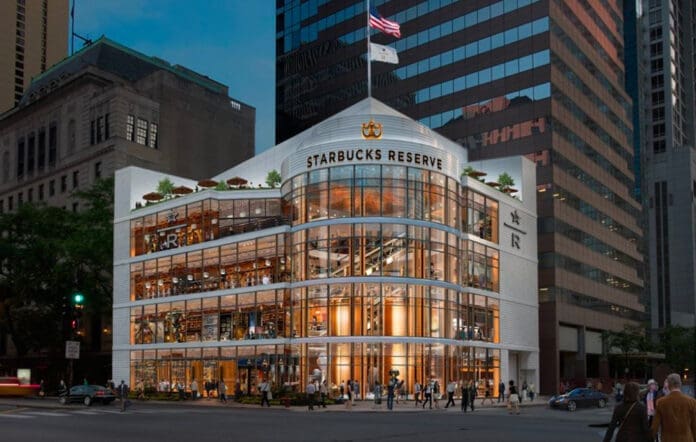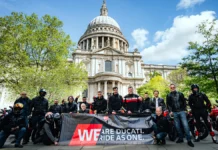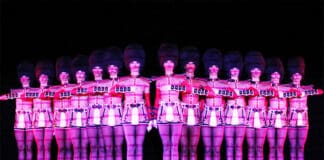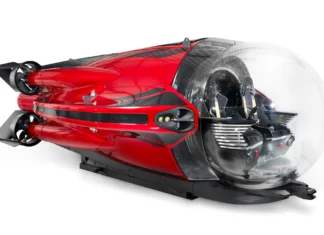When the Starbucks Reserve Roastery opens in Chicago next week, it will be a crowning moment for the company’s three decades in the city. But its success was anything but assured — it took a big gamble, a little convincing, and a few lucky breaks to make it in Chicago … and the world.
Almost exactly 32 years ago, a tiny notice appeared in the Chicago Tribune’s weekly entertainment section. Past the review of a Def Leppard concert and the movie listings for “Fatal Attraction” and “The Princess Bride,” there’s a bullet under Restaurant Notes that reads, “Starbucks Coffee decided Chicago is the place to start a national expansion.”
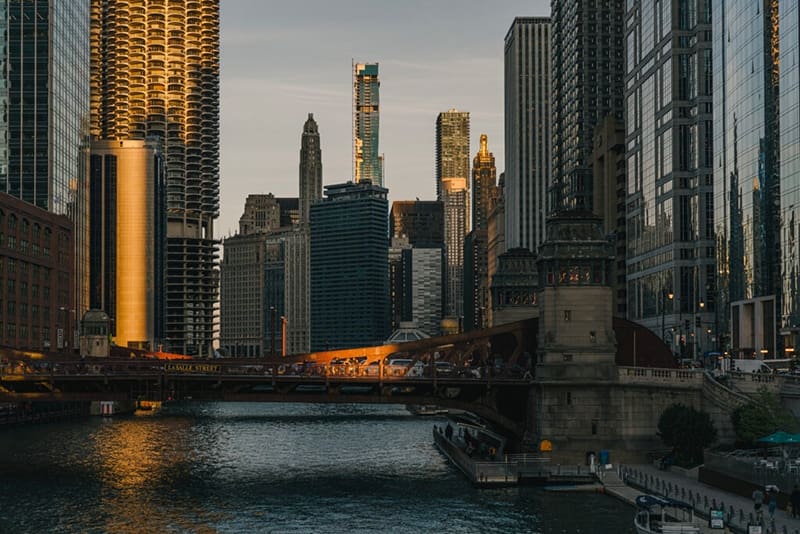
The announcement about the opening of Starbucks first store in the city was followed by a reminder to readers that the last Seattle business to try to break into the Chicago food and beverage market closed after just a few months.
With only 11 stores in Seattle and Vancouver, B.C., Starbucks had bet its future on Chicago, eager to prove its allure could extend beyond the Pacific Northwest. Howard Schultz recalled in his book, “Pour Your Heart Into It,” that most business experts advised against expanding to Chicago before establishing a stronger regional base in the Northwest. “Chicagoans, I was told, would never drink dark-roasted coffee,” he wrote. “But … we jumped feet first into Chicago, so in love with our product that we couldn’t imagine that everybody else wouldn’t love it, too.”
It wasn’t exactly an auspicious start. The opening of its store at 219 W. Jackson, in the business district called the Loop, on October 19, 1987 just happened to be “Black Monday,” the day the stock market crashed.
“But it was a disaster for other reasons,” Schultz wrote. “I didn’t realize that to be successful in Chicago’s Loop we needed to open into a lobby. Because the winters are so cold and windy, no one wants to walk outside to get a cup of coffee.” The location would close less than three years later.
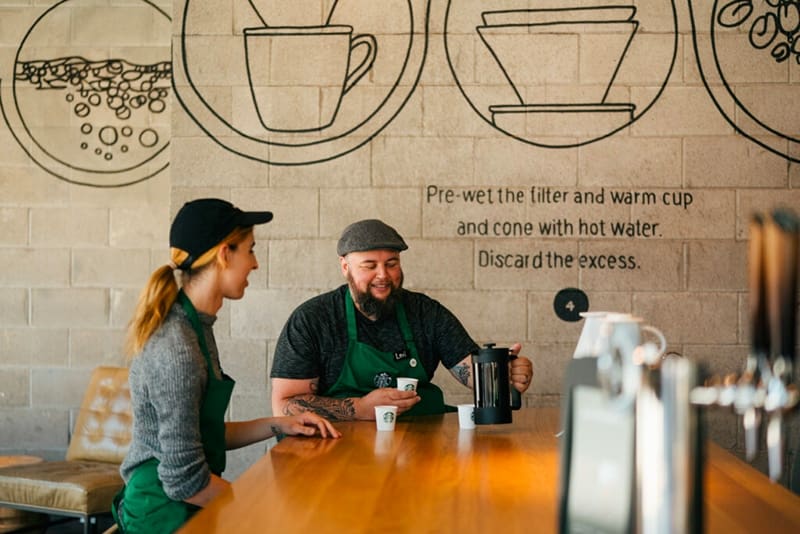
But the company would go on to open two new stores downtown in 1987, learning along the way. The next year, the Tribune would take notice of what it calls the “greening” of Chicago, with the appearance of the Starbucks logo popping up storefronts around town, including a spacious location downtown on Rush Street. America’s interest in specialty coffee is starting to “perk up,” it declared.
Dai Ichikawa, a 30-year Starbucks partner who works in Store Development, started with the company as a barista in 1989 at the Lake Forest store on the North Shore, its fourth location in the Chicago area and first in the suburbs. Working weekends in college, he scooped fresh-roasted coffee shipped from Seattle into bags and made espresso beverages at the bar.
“Your choices were latte, cappuccino, latte macchiato, americano, and the brewed coffee of the day,” he said. “There was no such thing as a Frappuccino. There were no ovens. Cookies were delivered from a local bakery and put into glass jars.”
His store didn’t have soft seating then, just had wooden stools and tall café tables — but it still felt like a community. “We were so small then, customers assumed we were a local company,” he said.
Cup by cup, customer by customer — word about Starbucks began to get around. Although the company struggled financially in the city in these early years, the business began to turn a corner in 1990 as the company found ways to improve the economics of each store, added kiosks in Dominick’s grocery stores and expanded its whole-bean coffee business to restaurants. Employees (who would soon be called partners) rallied around its new mission statement, “To establish Starbucks as the premier purveyor of the finest coffee in the world while maintaining our uncompromising principles as we grow.”

Ichikawa worked as a manager trainee in one of these kiosks once he finished college, introducing thousands of new customers to Starbucks and convincing them to swap the cans of coffee in their grocery carts for a fresh-roasted bag from Starbucks. His father, who came from the restaurant business, had advised him against his new career path. “Trust me,” Ichikawa told his dad. “There’s something different about this company. It’s more than just a coffee shop.”
By 1992, when the company was about to go public, it was safe to say Chicago had embraced Starbucks as its own. One article from the time noted how Chicagoans were now “clutching Starbucks to-go mugs, speaking to each other in Starbucks code: ‘Want to go for a grande skim dry decaf latte?’”
Have coffee, will travel
Chicago helped the brand take flight in more ways than one. In 1993, the company opened its first store at Chicago’s O’Hare airport with a licensed location in Terminal 3, which quickly became one of the busiest locations in the company. Ten more O’Hare locations would open in the next five years, with hundreds of travelers trying Starbucks for the first time there each day, then picking up pounds of Starbucks Gold Coast Blend coffee (created to honor Chicago) to bring to home to destinations around the world.
New experiences
The city would also go on to become a proving ground for new customer experiences — large and small. In 1995, Chicago became home to the world’s largest Starbucks (for a time) when its Rush Street store moved into a 4,000+ square-foot space with comfy chairs and a fireplace. The store would move again in 2012 (this time across the street) to a two-story space to become the first store east of Seattle to adopt the company’s new, more environmentally conscious, store design approach.
Store designer Jill Enomoto used the store as a showcase for this transformative store design strategy which improved the environmental performance of the store (which became officially LEED certified 2016) and connected customers to the story of coffee and conversation.
They reimagined the design of the coffee bar to include manual espresso machine and pour-over brewing along a long, low bar with stools that invited customers to stay and chat with baristas — elements that have been adopted into future Starbucks Reserve coffee bars and roastery locations.
“Oak & Rush is a very special store for the company,” Enomoto said. “It gave a different coffee experience to the customer where they were encouraged to linger, get a second or third cup and then really kind of have a different coffee experience. It was this great opportunity to do a little bit of a shift.”
In 2016, Chicago also opened one of the company’s smallest stand-alone locations, in Union Station. The compact 635-square-foot express concept store used a new high-tech ordering and service model to allow busy train passengers to grab their coffee and go at record speed.
Later that year, Starbucks also opened a Community Store in the Englewood neighborhood of Chicago’s South Side as part of its program to open stores in diverse urban communities across the United States. “Opening in Englewood is not just an opportunity to grow our business, but to be part of a local solution for social change,” said Rodney Hines, director for U.S. Social Impact.
Coming full circle
Now in 2019, Starbucks is coming back to Chicago to open what will once again be the largest Starbucks in the world with the Starbucks Reserve Roastery. The stunning five-story location on downtown’s Michigan Avenue will celebrate everything Chicago and Starbucks have built together over the last 30 years — the experience, the craft, and the coffee.
The Starbucks Reserve Roastery in Chicago will be the largest Starbucks in the world, opening November 15, 2019. Enomoto, who is now a vice president leading the Chicago Roastery’s design, can’t wait to unveil the company’s newest coffee showcase on Nov. 15. “From design and construction to all the operational training, for us it’s extremely rewarding. We are excited about what we’re about to launch,” she said.
Starbucks president and chief executive officer Kevin Johnson also gave a hint to what’s ahead on Starbucks earnings call last week when he called it “a beautifully designed, iconic” store. “I can’t wait to celebrate this opening with our partners and customers,” he said.
For Ichikawa, opening the Chicago Roastery represents a full-circle moment, almost exactly 30 years after he first started with the company.


